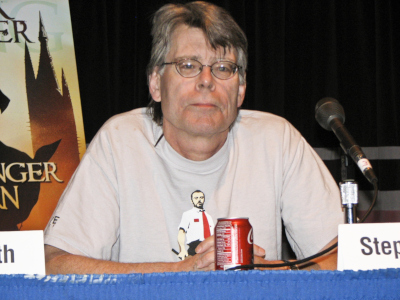Is Stephen King having a moment? Just this month, the second half of the film adaptation of his classic horror novel, It (titled It: Chapter Two), pulled in more than $150 million in America alone in its first nine days. Last week, his 61st novel, The Institute, hit stores. The movie version of his sequel to The Shining, Doctor Sleep, arrives in November. And streaming services positively hum with ongoing and upcoming adaptations of his work, including a new version of The Stand. It may seem like “a moment,” but the truth is that he’s been having an ongoing collection of moments since he became a pop culture force 45 years ago with the release of Carrie. Twenty-five years ago, King was in the middle of another pivotal September, one that would see the release of both a classic film and a novel that fundamentally changed the universe for King’s “constant readers.”

In 1982, King published Different Seasons, a collection of four novellas: The Breathing Method, The Body, Apt Pupil, and Rita Hayworth and Shawshank Redemption. The stories were distinguished from his novels at the time by mostly falling outside of the horror genre. Owing in part to King’s popularity, Hollywood came knocking for the non-horror material, too. The Body was adapted as Stand by Me in 1985, and Apt Pupil, after an abortive attempt ran out of money in 1987, saw screens in 1998.
The film adaptation of Rita Hayworth and Shawshank Redemption eventually came to life through a writer and director who King had previously allowed to film one of his short stories. Frank Darabont had been one of King’s first “Dollar Babies.” That was the nickname given to beneficiaries of King’s policy of allowing students or otherwise aspiring filmmakers to license one of his short stories for one dollar.
Darabont cast Tim Robbins and Morgan Freeman in the leads for the period prison drama. Despite King’s best-selling writer status and proven track record in generating box office dollars, the studio decided to keep King’s name out of the marketing due to his association with horror. In various interviews, King himself has remarked on this disconnect, including a frequently memed conversation he had with an older lady in a supermarket who, when he pointed out that he’d written Shawshank, retorted, “No, you didn’t.” Upon its September 1994 release, the film had a slow start; Forrest Gump was in the middle of its dominating 42-week box office run, and Shawshank went into wide release on the day that Pulp Fiction opened. Squished between two pop culture phenomena and the ongoing runs of The Lion King and lingering action films like Speed and True Lies, the film stiffed.
In a King-like twist, Shawshank came back from the dead due to the necromancy of home video. Warner Home Video shipped more than 300,000 rental copies of the film to outlets like Blockbuster, sensing that the movie might get a second life. They guessed right, and it went on to do huge rental business and was subsequently nominated for seven Academy Awards, including Best Adapted Screenplay (for Darabont), Best Actor (for Freeman), and Best Picture. While it didn’t win, the nominations cemented the image of the film in the public eye as a quality work. It’s thrived on video and television airings ever since. For the past 11 years, it has been #1 on IMDB.com’s user-created list of Top Films. It has also been preserved in the National Film Registry by the Library of Congress.
Within a few days of the initial limited September release of The Shawshank Redemption, King put out a new novel called Insomnia. The book came two years after his 1992 one-two punch of Gerald’s Game and Dolores Claiborne, a pair of novels about women endangered by abusive men and linked by an eclipse. This time, the protagonist, Ralph Roberts, was an elderly widower dealing with his increasing inability to sleep. As the plot runs further and further into a supernatural direction, King pulls out his big surprise roughly three-quarters of the way through: Roberts’s real mission is to save the life of young boy whose existence is critical to the success of another mission, that of The Gunslinger, Roland Deschain, protagonist of King’s The Dark Tower series.
This bombshell revelation did something that King had never done before. Whereas readers understood that the “Castle Rock” books (like Cujo, The Dead Zone, and Needful Things) were connected, and that It and Insomnia both took place in Derry, for example, here was the author planting a flag that the entire span of his stories were connected in one overarching narrative. That meant that seemingly disconnected threads like The Dark Tower and Insomnia were not only connected, but could impact one another. King would make this even more explicit in the fourth Dark Tower book, Wizard and Glass, in 1997, when the main characters crossed over into the world of The Stand. King’s own notes in the book stated that, “I am coming to understand that Roland’s world actually contains all the others of my making.”

The implication from that point forward was that whenever you read a King book, you weren’t just reading a story in isolation; you were reading something that could also been seen as part of a vast tapestry of interconnected worlds, stories, and ideas. The author’s multiverse has been tracked in two editions of The Stephen King Universe, a book compiled by writers Stanley Wiater, Christopher Golden, and Hank Wagner. And though The Dark Tower has ended (we think), King isn’t slowing down with the connections; after Holly Gibney, a protagonist of King’s Bill Hodges Trilogy, popped up in 2018’s The Outsider, King has since promised that she’s the lead character in next year’s If It Bleeds.
Decades after his commercial breakthrough, King never seems to stop having “moments.” He’s earned Grandmaster status from both the Mystery Writers of America and the World Horror Convention. In 2003, he received the National Book Award Medal of Distinguished Contribution to American Letters; in 2014, he was also awarded a National Medal of Arts from the National Endowment of the Arts. His short stories, novels, and the various adaptations of his work continue to be wildly popular. If such moments are themselves stories, then it’s easy to understand in this way: everyone has stories; it’s just that Stephen King is more prolific than the rest of us.
Featured image: Atlaspix / Alamy Stock Photo.
Become a Saturday Evening Post member and enjoy unlimited access. Subscribe now


